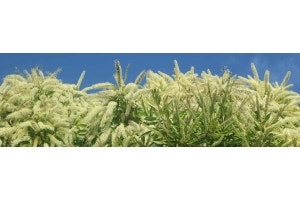
Sometimes it seems like plant names are terrifyingly and unnecessarily complicated. Like they are in Klingon, not English. Can't we just call them all by their common names?
Why are plant names so apparently difficult – and how can you get to understand them better?
A plant’s botanic name is made up of two or three parts, just like our own name. Let's look at two of our best sellers.



(The proper way to write this is the genus and species in italic, and the cultivar name not italic and in single quotes.)
Often the Genus and Cultivar - surname and stage name - are used without the species name, as in Murraya Min a Min.
- Murraya paniculata 'Min a Min'
- Lomandra confertifolia 'Little Con'

Genus - the family name
The 'genus' name of a plant in botany is like our family name or surname. It comes first with plants – so you get an idea of their general characteristics.- Murraya – a big family of shrubs and trees native to Asia and Australia, with aromatic leathery leaves and fragrant flowers.
- Lomandra - a small family of tufty perennials native to Australia and nearby islands, with grassy leaves and fibrous roots.

Species - the given name
The 'species' name of a plant is like our given name or what we call our first name – it gives you a more specific idea of how this plant is different to its relatives.- paniculata – which describes the arrangement of its flower stems; and is an evergreen plant native to Asia and far northern Australia, with small fragrant flowers.
- confertifolia - which describes the crowded or dense foliage; and is a large grassy perennial native to the east coast of Australia

Cultivar - the variety name
After these two parts, there may be another part, which is the cultivar name - from CULTIvated VARiety, ie bred or selected by humans, not Mother Nature. It's like a stage name for celebrities!(The proper way to write this is the genus and species in italic, and the cultivar name not italic and in single quotes.)
Often the Genus and Cultivar - surname and stage name - are used without the species name, as in Murraya Min a Min.
- 'Min a Min' - a kind of Murraya which grows shorter than M. paniculata, and with smaller, brighter green leaves.
- 'Little Con' - a kind of Lomandra which grows much shorter than L. confertifolia. Sometimes a plant becomes known more by its cultivar name than its botanic one - like 'Banjo' Paterson and Crocodile Dundee. Ten points if you remember either of their first names!
However, there might be several Banjo-Paterson plant equivalents, which is why it's always handy to refer to plants by their botanic name, so you know it's Andrew Barton Paterson you mean, and not Fred Paterson who plays ukelele in the local folk group.

For example, we have three plants called Red Robin in our range - a leafy indoor begonia, a frost-hardy hedging photinia, and a herbaceous summer-flowering peony. You wouldn't want to mix those up! Sometimes big brands decide on a brand name or trade mark name for a plant to promote it, or to honour a celebrity or charity. You might see the TM or R symbol after the name.
This is ok if you still have the botanic name to refer to, but confusing if all you have is that trade mark name. These names often change with fashion, or from country to country, and the same plant can have several in its lifetime. It also tells you nothing about the plant, unlike the botanic name which can often be quite informative. Read our post Learn to Speak Plant - what plant names can tell us , which shows you how to decode botanic names.
Common name - the nickname
A plant may also have a nickname, just like people do! People call them by this name day to day, rather than their real name; but they use their real name for official purposes.
images: Australian dogwood; Caribbean dogwood;cropped to size.
For example, "dogwood" usually means Cornus, a decidous north American shrub or tree with white and pink flowers, red berries, and bright bark. But it also can mean many other plants, including two wattles, two emu bush, several Tasmanian shrubs, an Asian vine, a Caribbean tree, and a variety of Azalea. For half the planet, "mock orange" is the soft-leaved frost-hardy Philadelphus, and for the other half it's the glossy tropical Murraya. Both have sweet scented white flowers, but only one will come through a harsh winter.Common name confusion
As well as one nickname referring to many different plants, one plant can have many different nicknames.A plant's nickname, just like a person's, may only be used by a few people, or in a few countries. Murraya is also known as mock orange, orange jessamine, bark tree, Chinese box, Lakeview jasmine, satinwood, and mock lime.
Lomandra is also known as mat rush, spiny headed mat rush, creek mat rush, fish bones, basket grass, and wattle rush. And just as nicknames can be misleading (redheads called Blue, short people called Lofty...), plant nicknames aren't always helpful. There are many plants called rose - primrose, rock rose, sunrose, peony rose, rose of sharon - which aren't true Rosa roses at all, or indeed anything like them. That's why we list most of our plants under their botanic name, so all the same genus - family members - are together, which makes them easy to find.
If you really want to be sure of what you’re buying, look for the botanic name!






















